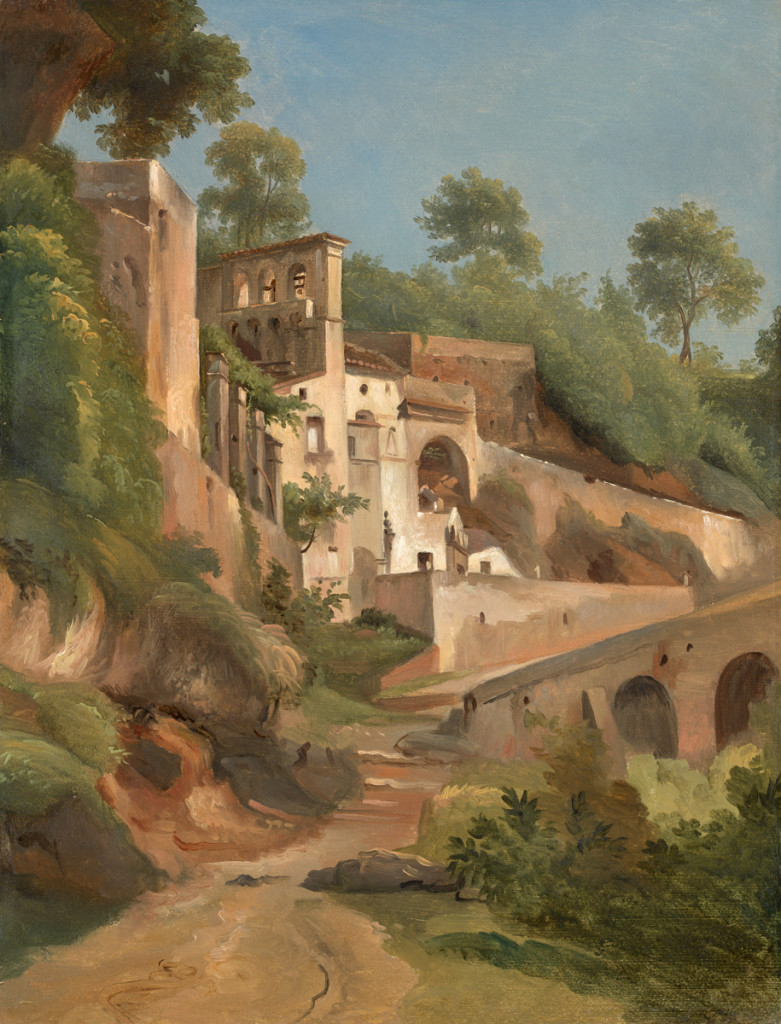André Giroux (1801 - Paris - 1879)
Santuario dell'Avvocatella in Cava de' Tirreni, 1827-9
Oil on paper on canvas, 28.3 x 21.5 cm
Provenance:
Wertheimer Foundation
Literature:
Vincent Pomarède, Alexander D. Grishin and Denis Canguilhem (eds.), André Giroux, London 2004, p. 38, no. 9, repr.
Long neglected by art critics, André Giroux is today accepted as one of the leading exponents of the generation of early nineteenth-century landscapists who engineered the transition from staged, neoclassically composed landscapes to a more naturalistic style. Giroux's chief interest focused on the natural world, albeit a natural world cultivated by man. He found a wide range of subjects in the countryside of central Italy, which had been populated since pre-Roman times. His focus on landscape was to continue into his later career as a photographer.[1]
The present architectural study was executed on Giroux's sojourn in Italy in the years 1825 to 1829. He had been awarded a Prix de Rome which enabled him to study at the Villa Medici in Rome. From Rome, many artists chose to travel southwards to Naples. A favourite spot for many nineteenth-century visitors on this popular route was the village of Cava de' Terreni near Salerno. The village lies somewhat off the beaten track in the hills overlooking the Amalfi coast. Members of what is now known as the Scuola di Posillipo - Neapolitan plein-air painters like Anton Sminck van Pitloo (1791-1837)[2] and Giacinto Gigante (1806-76) - produced numerous drawings and paintings of Cava and its environs.
Like Gigante and Pitloo, Giroux also visited Cava de' Terreni and is known to have produced a number of plein-air studies there. One of these is the small-format painting titled Gorge, Corpo di Cava. Executed in 1827, it is now in the Musée Boucher-de-Perthe in Abbeville.[3] The present study depicts the Santuario di Maria Santissima Avvocatella, a place of worship dedicated to the Virgin Mary, situated between Cava de' Terreni and Badia di Cava. The Sanctuary owes its existence to a priest who is reputed to have repelled a demon with the words Jesus and Maria in what is known as the 'Grotto of Bats' in 1654. The grotto was incorporated into the architecture of a pilgrimage church in 1702.[4]
[1] See André Giroux, op. cit., p.44. Giroux took up photography in his later career. His first photographs date from the early 1850s but he had almost certainly started to experiment with the new medium earlier. His brother and business partner Alphonse-Gustave Giroux worked closely with Louis-Jacques-Mandé Daguerre from 1839 onwards. It was Daguerre who invented the first commercial photographic process and developed a camera specially designed to produce 'daguerrotypes'. André Giroux retouched the photographs and the wet-collodion plates, producing extraordinarily evocative painterly effects. See André Giroux, op. cit., pp.32-3 and 44-9. [2] Anton Sminck van Pitloo, Avvocatella di Cava, oil on canvas, Naples, Fondazione Biblioteca Benedetto Croce. [3] Gorge, Corpo di Cava, 1827, oil on paper on canvas, 24 x 29 cm, Abbeville, Musée Boucher-de-Perthes; see <http://www.latribunedelart.com/la-donation-jean-louis-potier-au-musee-d-abbeville> (accessed 23 January 2014). [4] For a history of the Sanctuary, go to <http://www.avvocatella.it> (accessed 23 January 2014).

